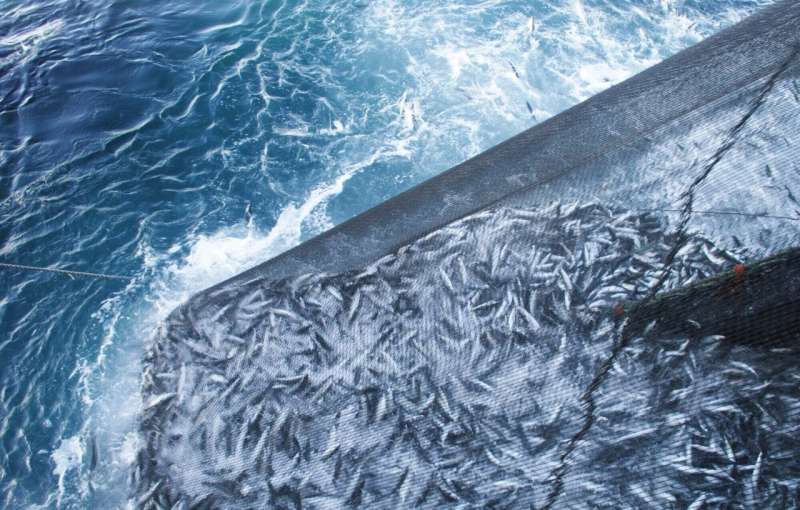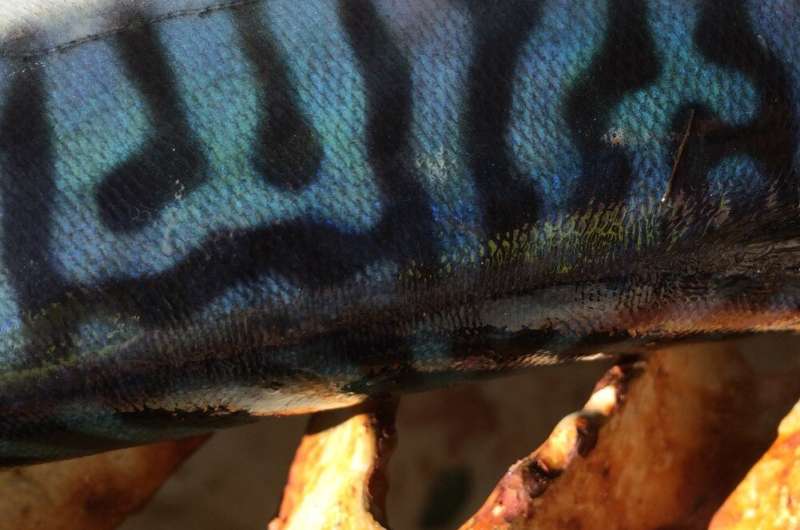Crowding-induced stress gives mackerel the blues

When mackerel die, they change color from green to blue. After seeing that live mackerel can also turn blue, a team of researchers wondered if this was because the fish were under stress. Their concerns proved to be correct.
"We've now succeeded in demonstrating that skin color in mackerel changes when the fish are exposed to high levels of stress," says Guro Møen Tveit, who is a Research Scientist at SINTEF. "We can use this knowledge to safeguard fish welfare and improve catch quality," she says
Important for fish welfare
Mackerel are normally caught using nets called purse seines. Purse seine fishing operates by "casting" an enormous, curtain-like net in such a way that it totally surrounds an entire shoal of fish. A standard purse seine may easily be between 800 and 900 meters long, with a diameter of between 140 and 150 meters. A single cast may contain several hundred tons of fish. Thus, at stake in this situation is the welfare of a huge number of animals, as well as enormous monetary value. For this reason, it is important to have control over the process. Detecting when the fish become stressed will enable the fisheries sector to apply future technologies resulting in effective modifications to the catch process.
"We envisage installing a monitoring system in the nets that will help trawler operators to better control the catch process," says Tveit. "We can then use changes in mackerel skin color, together with other welfare indicators, such as intra-shoal organization, fish density and swimming behavior, as aids in the implementation of easier and better modifications of the process. This will safeguard the welfare of the fish and ensure optimal fish meat quality into the bargain," says Tveit.
The major benefits of observing stressed fish
Researchers have been focusing for some time on finding ways to measure the stress to which fish are exposed by means of observation, rather than by methods that involve handling the fish themselves.
"Fish exhibit several different indicators of stress and general welfare," says Tveit. "The detection of some of these requires handling the fish and are impossible to carry out during catch processes using purse seines. One example is blood tests. Other indicators are visible and can thus be observed, such as fish crowding densities and how a shoal moves once it is trapped inside a net. Now, we can also use skin color as a stress indicator," she says.

Crowding experiments
In order to demonstrate that mackerel turn blue when they become stressed, SINTEF carried out an experiment with the Norwegian Marine Research Institute at its facility in Austevoll in Hordaland.
"We subjected the mackerel to various crowding densities, from very low, to moderate, to high," says Tveit. The results showed that the fish begin to change color when they experience high levels of crowding over long periods," she says.
This research was part of the now completed project called "Fangstkontroll i notfiske etter pelagiske arter" (Catch process control in pelagic purse seine fisheries), which had the aim of developing a better catch process for purse seine trawlers.
Key decision support
"An ability to use color change as a measure of stress will be additionally important during fish crowding in purse seines," says Tveit. "Not only for the regulation of crowding densities, but also during drying of the nets," she says.
"Crowding becomes a major stress factor for mackerel when the net is being hauled in," says Tveit. "If we are able to recognize stress and regulate the catch process accordingly, this will benefit not only the survival of the fish that manage to escape, but also the quality of the fish that end up on consumers' plates. It will also make a massive contribution towards boosting sustainability in the fisheries sector," she says.
Provided by Norwegian University of Science and Technology



















